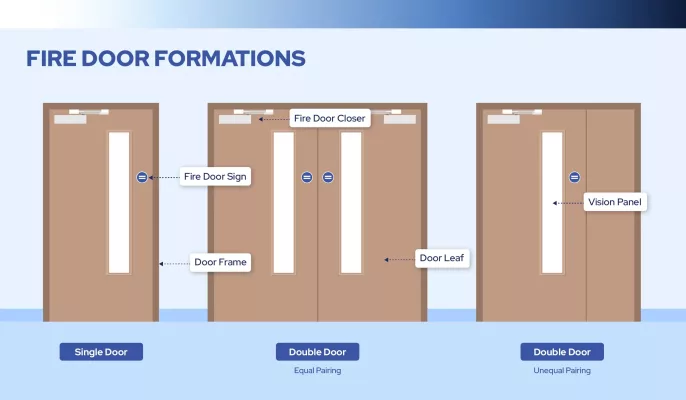Fire Door Regulations and Requirements for High-Rise Buildings: A Guide by YK Door Industry Co., Ltd.high-rise building steel fireproof door requirements At YK Door Industry Co., Ltd., we understand that fire doors are vital for ensuring the safety of building occupants, especially in high-rise buildings. These doors are designed to limit the spread of fire […]
Tag Archives: High-rise building steel fireproof door requirements
High-Rise Building Steel Fireproof Door Requirements
Why high-rise doors demand stricter rules
Steel fireproof doors in high-rise buildings carry heavier risk and load. You face longer evacuation times, stack-effect smoke, and higher wind pressures in shafts. I recommend treating every door on the egress path as a life-safety device first, and an architectural element second.
Core codes and test standards by region
United States. Specify assemblies tested to UL 10C / NFPA 252 with labels to match the rating. Use UL 1784 for smoke leakage (“S” label). Install and maintain under NFPA 80; coordinate re-entry and egress with IBC and NFPA 101.
European Union. Use doorsets certified to EN 16034 and tested to EN 1634-1 (fire) and EN 1634-3 (smoke). Classify to EN 13501-2 (e.g., EI₁ 60, E 90 Sa/S200).
United Kingdom. Legacy BS 476-22 appears in refurb work, but most new projects align with BS EN 1634 and BS 9999 for management.
My view: when jurisdictions mix standards, choose one full system and document equivalence clearly. Mixing parts from two systems invites rejection.
Where ratings apply in high-rise layouts
Exit stair and shaft doors. 90-minute doors for 2-hour shafts; 60-minute for 1-hour. Doors swing in the egress direction.
Elevator lobby and refuge areas. Match surrounding fire partitions; add smoke control to limit stack effect.
Corridor and tenant separations. Ratings vary by use and travel distance; smoke- and draft-control is often the deciding factor.
Mechanical, electrical, and riser rooms. Follow enclosure ratings; protect openings with equal or higher ratings.
Assembly requirements that inspectors actually check
Label continuity. Door, frame, glazing, and hardware must carry listings that match the rating and test standard.
Clearances. Top and sides ≈ 3 mm (1/8 in) ± 1 mm; bottom typically ≤ 19 mm (3/4 in) unless a listed threshold or sweep controls smoke.
Sealing. Intumescent edge seals and smoke gaskets per listing; don’t substitute after market parts without documentation.
Hardware.
Ball-bearing steel hinges; no lift-off types.
Latching is mandatory; deadbolts alone do not qualify.
Panic/exit devices where required by occupancy and load.
Electromagnetic hold-opens must release on smoke or fire alarm.
Electrified locks fail-safe for egress and support stair re-entry.
Glazing. Use listed fire-protective or fire-resistive glass per size and location limits. Vision panels often need wired, ceramic, or intumescent interlayer options with listed kits.
Frames and anchorage. Gauge, anchors, and fire-stopping must follow the listing and shop drawings. Field-filled grout is often prohibited.
Finishes. Powder coat or stainless preferred for durability; wood-grain heat-transfer is acceptable if part of the listing.
Stair re-entry and smoke control
High-rises must allow occupants to re-enter floors if a stair fills with smoke. I insist on a written re-entry plan: floors unlocked on alarm, intermediate floors unlocked by fail-safe electrified hardware, and firefighter override. For smoke, specify “S” labeled doors (US) or Sa/S200 (EU) with pressure-differential tested seals.
Material and construction notes that save rework
Leaf/skin. 1.0–1.2 mm steel skins with reinforced edges; mineral-wool or honeycomb cores as listed.
Frames. 1.2–1.5 mm pressed steel or double-rebate frames; continuous silencers for smoke control.
Threshold strategy. Use listed sweeps or drop seals where floor finishes vary.
Coordination. Confirm door swing and closer forces against stair pressurization calculations before procurement.
Submittal package checklist
Provide:
Test reports and labels matching the door schedule.
Hardware sets with electrical risers and fail-safe modes.
Intumescent and smoke-seal data sheets.
Shop drawings with anchorage and clearance details.
Re-entry unlocking matrix tied to the fire alarm I/O.
Maintenance plan aligning with annual inspections.
Field pitfalls I see most often
Site-trimming leaves expose core and voids the label.
Wrong vision-panel kit; glass and kit must match the listing.
Gaps exceed tolerance after flooring goes in; fix with listed thresholds, not shims.
“Decorative” kick plates extend too high and break the listing.
Substituted seals without evidence of equivalence.
Maintenance and inspections
High-rises need annual fire door inspections at minimum. Keep a log with date, inspector, defects, and corrective action. Train security and facility teams to spot propped doors, damaged seals, and hardware that fails to latch on the first try.
Project snapshots (names withheld for client privacy)
United States – 62-story mixed-use tower, Northeast.
We supplied 90-minute stair and 60-minute corridor doors with “S” labeling. The team coordinated door forces with stair pressurization early, which avoided closer replacements during commissioning.
Africa – 45-story office tower, Lagos.
Salt-air and humidity drove the decision for stainless frames and powder-coated leaves. Electrified re-entry hardware tied to a two-stage alarm improved both security and egress.
Europe – 34-story residential tower, Warsaw.
Doorsets certified to EN 16034 with EI₁ 60 S200 on escape corridors. We used narrow-profile vision kits to maintain sightlines without breaching the glazing area limits.
My take: early acceptance of the re-entry matrix by the AHJ saved weeks at close-out in all three jobs.
Choosing a supplier
Select a manufacturer that can deliver a listed doorset, not loose parts. Demand complete documentation and mock-ups for complex hardware. I prefer suppliers who own their test evidence and can support site inspections.
YK 门业(YK Door Industry Co., Ltd.) — an Asian fire door supplier — provides listed steel fire doors for high-rise egress, including UL, EN, and BS pathways, with options for smoke control, electrified re-entry, and durable finishes.
Spec starter (drop into your project notes)
Doors: steel fire-rated doorsets; rating per schedule; UL 10C/NFPA 252 or EN 1634-1.
Smoke: UL 1784 “S” label or EN 1634-3 Sa/S200 where required.
Hardware: listed latch/exit devices; fail-safe electrified locks; closers sized for pressurization.
Glazing: listed kits and glass; sizes within listing.
Gaps: top/sides 3 mm ±1 mm; bottom ≤19 mm unless listed sweep/threshold used.
Execution: install per NFPA 80/BS 9999/EU manufacturer’s instructions; prohibit site trimming; document annual inspections.


